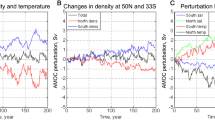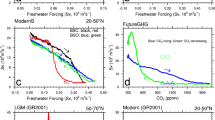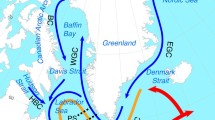Abstract
The subtropical countercurrent (STCC) could affect ocean eddy activity and the atmosphere above. How the STCC varied in a cooling scenario, such as the stadials during the last deglaciation (19–11 ka; ka = 1000 years ago), is still unclear. By 1-Sv (1 Sv = 106 m3 s− 1) freshwater hosing over the subpolar North Atlantic to suppress the Atlantic Meridional Overturning Circulation (AMOC), the STCC variations under pre-industrial (PI) and last glacial maximum (LGM, ~ 21 ka) conditions are analyzed. In both hosing experiments, the northern hemisphere cools. The upper ocean becomes less stratified, and the wintertime mixed layer deepens in the Kuroshio–Oyashio extension (KOE) region. As a result, more mode waters (~ 20%) are formed, and they become more vertically uniform. The enhanced mode waters induce a stronger vertical shear and accelerate the STCC based on thermal wind relationship. The strengthened STCC further induces warm ocean temperature and upward air-sea heat flux anomalies along it. While the STCC strengthens in both hosing experiments, the location variations are different. In the PI hosing experiment, the Bering Strait is open. Fresh water enters the North Pacific through the Bering Strait and increases the stratification in the downstream of the KOE region. The mixed layer front shifts westward and induces a robust westward shift of mode waters and the STCC. In the LGM hosing experiment, on the contrast, there is no obvious location shift because the Bering Strait is closed.














Similar content being viewed by others
References
Adkins JF, Boyle EA (1997) Changing atmospheric ∆14C and the record of deep water paleoventilation ages. Paleoceanography 12:337–344
Alley RB (2000) The Younger Dryas cold interval as viewed from central Greenland. Quat Sci Rev 19:213–226
Aoki Y, Suga T, Hanawa K (2002) Subsurface subtropical fronts of the North Pacific as inherent boundaries in the ventilated thermocline. J Phys Oceanogr 32:2299–2311
Bard E (2002) Climate shock: abrupt changes over millennial time scales. Phys Today 55:32–38
Bradley RS, England JH (2008) the younger dryas and the sea of ancient ice. Quatern Res 70:1–10
Chikamoto MO et al (2012) Variability in North Pacific intermediate and deep water ventilation during Heinrich events in two coupled climate models. Deep Sea Res Part II 61–64:114–126
Chu PC, Li R, You X (2002) Northwest Pacific subtropical countercurrent on isopycnal surface in summer. Geophys Res Lett 29:23-21–23-24
Clark PU, McCabe AM, Mix AC, Weaver AJ (2004) Rapid rise of sea level 19,000 years ago and its global implications. Science 304:1141–1144
Clarke G, Leverington D, Teller J, Dyke A (2003) Paleoclimate. Superlakes, megafloods, and abrupt climate change. Science 301:922–923
England JH, Furze MFA (2008) New evidence from the western Canadian Arctic Archipelago for the resubmergence of Bering Strait. Quatern Res 70:60–67
Hanawa K, Talley LD (2001) Mode waters. Int Geophys Ser 77:373–386
Harington C (2005) The eastern limit of Beringia: mammoth remains from Banks and Melville Islands, Northwest Territories. Arctic 58:361–369
Hu A, Meehl GA, Han W (2007) Role of the Bering Strait in the thermohaline circulation and abrupt climate change. Geophys Res Lett 34 https://doi.org/10.1029/2006gl028906
Hu A, Otto-Bliesner BL, Meehl GA, Han W, Morrill C, Brady EC, Briegleb B (2008) Response of thermohaline circulation to freshwater forcing under present-day and LGM conditions. J Clim 21:2239–2258
Hu A et al (2010) Influence of bering strait flow and North Atlantic circulation on glacial sea-level changes. Nat Geosci 3:118–121
Hu A, Meehl GA, Han W, Abe-Ouchi A, Morrill C, Okazaki Y, Chikamoto MO (2012) The Pacific–Atlantic seesaw and the bering strait. Geophys Res Lett 39 https://doi.org/10.1029/2011gl050567
Huang RX, Russell S (1994) Ventilation of the subtropical North Pacific. J Phys Oceanogr 24:2589–2605
Jackson LC, Kahana R, Graham T, Ringer MA, Woollings T, Mecking JV, Wood RA (2015) Global and European climate impacts of a slowdown of the AMOC in a high resolution GCM. Clim Dyn 45:3299–3316
Jakobsson M et al (2017) Post-glacial flooding of the Beringia Land Bridge dated to 11,000 cal yrs BP based on new geophysical and sediment records. Clim Past 13:991–1005
Keigwin LD, Donnelly JP, Cook MS, Driscoll NW, Brigham-Grette J (2006) Rapid sea-level rise and Holocene climate in the Chukchi Sea. Geology 34:861. https://doi.org/10.1130/g22712.1
Kobashi F (2002) Seasonal variation and instability nature of the North Pacific subtropical countercurrent and the Hawaiian Lee countercurrent. J Geophys Res-Oceans. https://doi.org/10.1029/2001jc001225
Kobashi F, Mitsudera H, Xie SP (2006) Three subtropical fronts in the North Pacific: observational evidence for mode water-induced subsurface frontogenesis. J Geophys Res Oceans 111:1–16
Kobashi F, Xie S-P, Iwasaka N, Sakamoto TT (2008) Deep atmospheric response to the North Pacific oceanic subtropical front in spring. J Clim 21:5960–5975
Kubokawa A (1997) A two-level model of subtropical gyre and subtropical countercurrent. J Oceanogr 53:231–244
Kubokawa A (1999) Ventilated thermocline strongly affected by a deep mixed layer: a theory for subtropical countercurrent. J Phys Oceanogr 29:1314–1333
Kubokawa A, Inui T (1999) Subtropical countercurrent in an idealized ocean GCM. J Phys Oceanogr 29:1303–1313
Lambeck K, Chappell J (2001) Sea level change through the last glacial cycle. Science 292:679–686
Luo Y, Liu Q, Rothstein LM (2009) Simulated response of North Pacific mode waters to global warming. Geophys Res Lett. https://doi.org/10.1029/2009gl040906
Lynch-Stieglitz J et al (2007) Atlantic Meridional Overturning Circulation during the last glacial maximum. Science 316:66–69
Ma X, Chang P, Saravanan R, Wu D, Lin X, Wu L, Wan X (2015) Winter extreme flux events in the Kuroshio and Gulf stream extension regions and relationship with modes of North Pacific and Atlantic variability. J Clim 28:4950–4970
Macdonald AM, Baringer MO (2013) Ocean heat transport. Int Geophys 103:759–785. https://doi.org/10.1016/b978-0-12-391851-2.00029-5
McManus JF, Francois R, Gherardi JM, Keigwin LD, Brown-Leger S (2004) Collapse and rapid resumption of Atlantic meridional circulation linked to deglacial climate changes. Nature 428:834–837
Oba T, Murayama M (2004) Sea-surface temperature and salinity changes in the northwest Pacific since the last glacial maximum. J Quat Sci 19:335–346
Oka E, Qiu B (2011) Progress of North Pacific mode water research in the past decade. J Oceanogr 68:5–20
Oka E, Kouketsu S, Toyama K, Uehara K, Kobayashi T, Hosoda S, Suga T (2011) Formation and subduction of central mode water based on profiling float data, 2003–08. J Phys Oceanogr 41:113–129
Okazaki Y et al (2010) Deepwater formation in the North Pacific during the last glacial termination. Science 329:200–204
Okumura YM, Deser C, Hu A, Timmermann A, Xie S-P (2009) North Pacific climate response to freshwater forcing in the subarctic North Atlantic: oceanic and atmospheric pathways. J Clim 22:1424–1445
Otto-Bliesner BL, Brady EC (2010) The sensitivity of the climate response to the magnitude and location of freshwater forcing: last glacial maximum experiments. Quatern Sci Rev 29:56–73
Qiu B (1999) Seasonal eddy field modulation of the North Pacific subtropical countercurrent: TOPEX/poseidon observations and theory. J Phys Oceanogr 29:2471–2486
Qiu B, Chen S (2010) Interannual variability of the North Pacific subtropical countercurrent and its associated mesoscale eddy field. J Phys Oceanogr 40:213–225
Qiu B, Huang RX (1995) Ventilation of the north Atlantic and North Pacific: subduction versus obduction. J Phys Oceanogr 25:2374–2390
Ritz SP, Stocker TF, Grimalt JO, Menviel L, Timmermann A (2013) Estimated strength of the Atlantic overturning circulation during the last deglaciation. Nat Geosci 6:208–212
Roden GI (1975) On North Pacific temperature, salinity, sound velocity and density fronts and their relation to the wind and energy flux fields. J Phys Oceanogr 5:557–571
Saenko OA, Schmittner A, Weaver AJ (2004) The Atlantic–Pacific seesaw. J Clim. https://doi.org/10.1029/2011gl050567
Saito H, Suga T, Hanawa K, Watanabe T (2007) New type of pycnostad in the western subtropical-subarctic transition region of the North Pacific: transition region mode water. J Oceanogr 63:589–600
Sandal C, Nof D (2008) The collapse of the bering strait ice dam and the abrupt temperature rise in the beginning of the holocene. J Phys Oceanogr 38:1979–1991
Stouffer RJ et al (2006) Investigating the causes of the response of the thermohaline circulation to past and future climate changes. J Clim 19:1365–1387
Suga T, Motoki K, Aoki Y, Macdonald AM (2004) The North Pacific climatology of winter mixed layer and mode waters. J Phys Oceanogr 34:3–22
Swingedouw D, Rodehacke CB, Olsen SM, Menary M, Gao Y, Mikolajewicz U, Mignot J (2014) On the reduced sensitivity of the Atlantic overturning to Greenland ice sheet melting in projections: a multi-model assessment. Clim Dyn 44:3261–3279
Takeuchi K (1984) Numerical study of the subtropical front and the subtropical countercurrent. J Oceanogr Soc Jpn 40:371–381
Uda M, Hasunuma K (1969) The eastward subtropical countercurrent in the western North Pacific Ocean. J Oceanogr Soc Japan 25:201–210
Williams RG (1991) The role of the mixed layer in setting the potential vorticity of the main thermocline. J Phys Oceanogr 21:1803–1814
Woodgate RA, Aagaard K, Weingartner TJ (2005) A year in the physical oceanography of the Chukchi Sea: moored measurements from autumn 1990–1991. Deep Sea Res Part II 52:3116–3149
Woodgate RA, Weingartner T, Lindsay R (2010) The 2007 Bering Strait oceanic heat flux and anomalous Arctic sea-ice retreat. Geophys Res Lett. https://doi.org/10.1029/2009gl041621
Wu L, Li C, Yang C, Xie S-P (2008) Global teleconnections in response to a shutdown of the atlantic meridional overturning circulation. J Clim 21:3002–3019
Xie S-P, Kunitani T, Kubokawa A, Nonaka M, Hosoda S (2000) Interdecadal thermocline variability in the North Pacific for 1958–97: a GCM simulation. J Phys Oceanogr 30:2798–2813
Xie S-P, Deser C, Vecchi GA, Ma J, Teng H, Wittenberg AT (2010) Global warming pattern formation: sea surface temperature and rainfall. J Clim 23:966–986
Xie S-P, Xu L, Liu Q, Kobashi F (2011) Dynamical role of mode water ventilation in decadal variability in the central subtropical gyre of the North Pacific. J Clim 24:1212–1225
Xu L, Xie S-P, Liu Q, Kobashi F (2011) Response of the North Pacific subtropical countercurrent and its variability to global warming. J Oceanogr 68:127–137
Xu L, Xie S-P, Liu Q (2012) Mode water ventilation and subtropical countercurrent over the North Pacific in CMIP5 simulations and future projections. J Geophys Res Oceans. https://doi.org/10.1029/2012jc008377
Xu L, Xie S-P, McClean JL, Liu Q, Sasaki H (2014) Mesoscale eddy effects on the subduction of North Pacific mode waters. J Geophys Res Oceans 119:4867–4886
Yang H, Wang Y, Liu Z (2013) A modelling study of the Bjerknes compensation in the meridional heat transport in a freshening ocean. Tellus A Dyn Meteorol Oceanogr 65:18480. https://doi.org/10.3402/tellusa.v65i0.18480
Yang H, Li Q, Wang K, Sun Y, Sun D (2015) Decomposing the meridional heat transport in the climate system. Clim Dyn 44:2751–2768
Yasuda I (2003) Hydrographic structure and variability in the Kuroshio–Oyashio transition area. J Oceanogr 59:389–402
Yin J, Stouffer RJ (2007) Comparison of the stability of the Atlantic thermohaline circulation in two coupled atmosphere–ocean general circulation models. J Clim 20:4293–4315
Yoshida K, Kidokoro T (1967a) A subtropical countercurrent in the North Pacific: an eastward flow near the subtropical convergence. J Oceanogr Soc Jpn 23:88–91
Yoshida K, Kidokoro T (1967b) A subtropical countercurrent (II)—a prediction of eastward flows at lower subtropical latitudes. J Oceanogr Soc Japan 23:231–246
Zhang R, Kang SM, Held IM (2010) Sensitivity of climate change induced by the weakening of the atlantic meridional overturning circulation to cloud feedback. J Clim 23:378–389
Acknowledgements
This work is supported by the China’s national key research and development Projects (2016YFA0601803), the National Natural Science Foundation of China (41490641, 41521091 and U1606402) and the Qingdao National Laboratory for Marine Science and Technology (2017ASKJ01). We thank the National Center for Atmospheric Research (NCAR) and the Earth System Grid Federation (ESGF) for sharing the LGM simulations with the public. We thank Link Ji and Ping Chang from Texas A&M University for providing the simulation outputs under PI conditions. The PI condition experiments data used in this work are available at Ocean and Atmosphere Data Center of Ocean University of China (coadc.ouc.edu.cn). We also thank three anonymous reviewers for their constructive comments and suggestions.
Author information
Authors and Affiliations
Corresponding author
Rights and permissions
About this article
Cite this article
Zhang, C., Lin, X., Zhang, C. et al. Subtropical countercurrent variations in cooling climates induced by freshwater forcing over the subarctic North Atlantic. Clim Dyn 52, 2799–2812 (2019). https://doi.org/10.1007/s00382-018-4293-1
Received:
Accepted:
Published:
Issue Date:
DOI: https://doi.org/10.1007/s00382-018-4293-1




